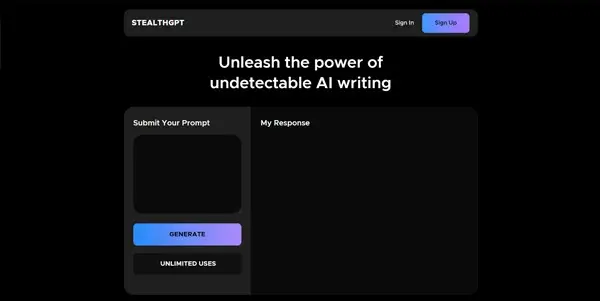StealthGPT

A GPT3 prompt that makes its content undetectable by AI detectors. Ideal for students
StealthGPT: Bypassing AI Detection in Written Content
What is StealthGPT?
StealthGPT is not a standalone AI tool, but rather a cleverly designed GPT-3 prompt engineered to generate text that evades detection by AI plagiarism and content originality checkers. It functions as a technique, leveraging the capabilities of existing large language models (like GPT-3, GPT-4, and similar), to produce content that appears to be human-written. This makes it particularly appealing to students and others who need to generate text that avoids detection of AI assistance. It's important to emphasize that the ethical implications of using such tools should be carefully considered.
Main Features and Benefits
The core benefit of StealthGPT lies in its ability to obfuscate the AI-generated nature of text. While not guaranteeing complete evasion of all detectors (AI detection technology is constantly evolving), it significantly increases the chances of avoiding detection. This is achieved through the prompt's design, which focuses on:
- Mimicking Human Writing Styles: The prompt incorporates instructions to emulate various writing styles, including sentence structure, vocabulary choice, and overall tone. This makes the output less predictable and more akin to human-generated content.
- Incorporating Subtle Variations: The prompt encourages the AI to introduce minor inconsistencies and deviations from perfectly structured text, mimicking natural human imperfections.
- Contextual Awareness: A strong StealthGPT prompt will emphasize the importance of generating contextually relevant content, thereby avoiding the repetitive or formulaic patterns often associated with AI-generated text.
Use Cases and Applications
While the potential uses are broad, StealthGPT's application raises ethical concerns. Its use should be approached responsibly. Examples include:
- Drafting Essays and Assignments: Students might use it to generate initial drafts, refining the output afterwards to ensure originality and accurate information. However, using it to plagiarize is unethical and potentially harmful.
- Creating Marketing Copy: Businesses might utilize it to overcome writer's block or generate initial drafts of marketing materials.
- Generating Creative Writing Prompts: Writers could use it to jumpstart their creative process, receiving unique and unexpected ideas.
It is crucial to remember that StealthGPT should be used as a tool to assist writing, not to replace it entirely. Any output generated should be thoroughly reviewed, edited, and fact-checked before submission or publication.
Comparison to Similar Tools
Unlike dedicated AI detection bypass tools, StealthGPT isn't a software program itself. It's a prompt engineering technique. This means it's less "plug-and-play" than some dedicated software, requiring a deeper understanding of prompt design and AI capabilities. Other tools offering similar functionalities might include paraphrasing tools or AI writing assistants that claim to produce human-quality content. However, these often lack the explicit focus on AI detection evasion that StealthGPT offers through its prompt design.
Pricing Information
StealthGPT operates on a freemium model. The core prompt design itself is freely available (through various online communities and tutorials). However, some advanced or specialized prompts, or access to refined versions, might be offered on a subscription or pay-per-use basis by individuals or services offering enhanced prompt engineering services. The cost will vary depending on the provider and the specific features offered.
Conclusion
StealthGPT represents a powerful tool with both potential benefits and significant ethical considerations. Its effectiveness in bypassing AI detection is dependent on several factors, including the sophistication of the detection software and the skill in utilizing the prompt. Users must approach it responsibly, understanding the implications of using AI-generated content and prioritizing originality and academic integrity. Always ensure proper attribution and ethical usage of any AI-assisted writing.